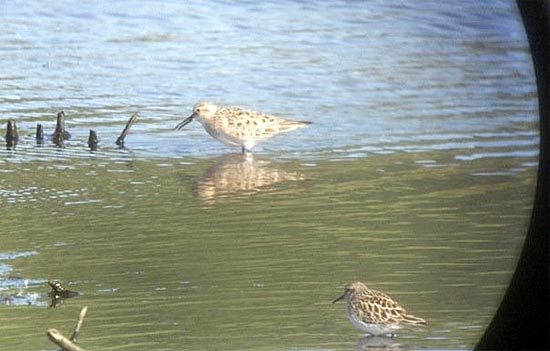Scout Week at the World Series of Birding
By Hugh Powell
May 10, 2010

Scout Week is the frantic 7 days before the World Series of Birding, when teams hurry to pin down the locations of some 230 bird species within the state of New Jersey, figure out a route that links them all, and then attempt to drive the route flawlessly in less than 24 hours. Nerves are always on edge: the birders either fret over birds that aren’t here yet, or fret that the birds that are here will leave before the big day (which is this Saturday, May 15).
I talked to one-half of Team Sapsucker (Chris Wood, Brian Sullivan, and Jessie Barry) on Sunday evening, as they were ordering dinner in Cape May after a long day battling wind and cold. The outlook sounded grim.
After a couple of good hours on Saturday morning, Brian Sullivan told me, the clouds had descended, the temperature dropped, and the wind picked up to a steady 30 mph. “As far as the breeding birds, everything seems to be here,” Brian said, “but you win or lose the World Series by 15 or 20 hard-to-come-by birds and those are the things we really worry about.”
The Delaware River was mobbed with late-migrant Blackpoll Warblers, but four of the hard-to-find species were distressingly absent: no Lesser Black-backed Gulls, neither of the “white-winged” gulls—Iceland and Glaucous—and no Great Cormorant, either.
Chris Wood and Jessie Barry were scouting southern Cape May, where the news wasn’t any more encouraging. By mid-May the Snow Goose flocks are mostly gone, for example, and the Sapsuckers know of just one or two spots to pick up stragglers. This morning, they enjoyed seeing a pair of Bald Eagles until they realized the raptors were eating one of the very last Snow Geese in New Jersey. The next nearest Snow Goose is 45 minutes out of their way.
“It’s so windy, every time you get out of the car the scope is just shaking violently,” said Jessie Barry, the team’s duck expert. “The water is kicked up and you can’t see all the ducks and grebes and loons in the waves the way you might on a calm day.” It’s hard to hear singing birds over the noise of the wind, too. The team noted on Facebook that even strident Northern Mockingbirds were hard to pick up.
That morning, Chris and Jessie had found a rare Scissor-tailed Flycatcher, far from its usual home in Texas and Oklahoma. That’s definitely a hard-to-find bird that will help the team’s checklist on May 15 if it sticks around (and avoids the Bald Eagles).
In the north, Andrew Farnsworth, Marshall Iliff, and Tim Lenz braced for snow flurries, and were rewarded with Lesser Scaup, American Wigeon, and, on Monday, a rare Baird’s Sandpiper (that’s it pictured above).
The Baird’s was a break that signified perhaps the second stage of Scout Week was approaching, when nerves settle and the first few good birds buoy the spirits. “It’s the typical apprehension before the event,” Jessie said. “But we’re just going to hope the wind dies down tonight so we can head out and listen for some marsh birds.”
At dawn, they’ll be back out on the roads and byways, ears cocked and binoculars at the ready. Four scouting days remain.
Donate to our World Series of Birding teams and follow them on Twitter and Facebook. All donations support our work for conservation!


All About Birds is a free resource
Available for everyone,
funded by donors like you






